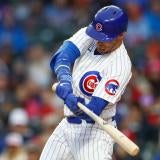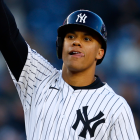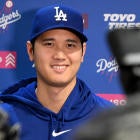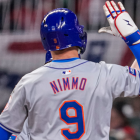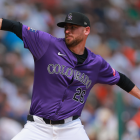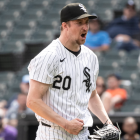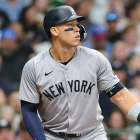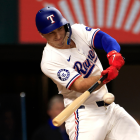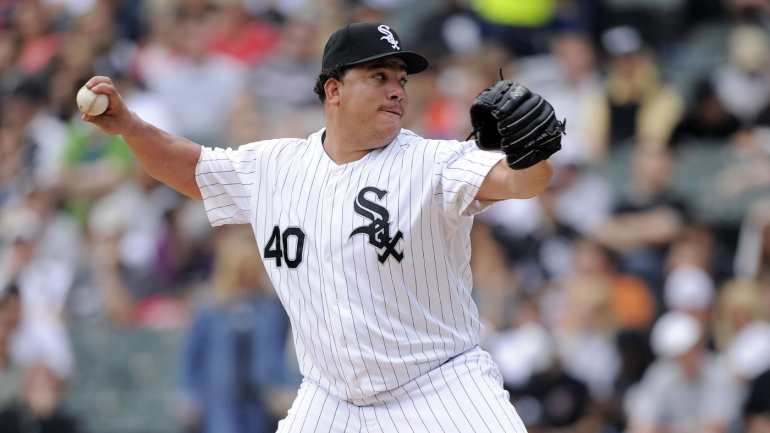
Baseball fans who love trivia and history have recently stumbled upon Immaculate Grid, an online game that tests your memory of lineups long forgotten. A new grid drops daily with nine squares to be filled in with Major League Baseball players past and present, based on their team and accomplishments. The main goal is to fill all nine squares correctly; some fans take it a step further by trying to pick the least popular players to fill their grid.
There's a handy list of rules when you first go check it out and you'd be better served looking on your own instead of having me try to explain everything. Recently purchased by Baseball-Reference, the game continues to grow in popularity so I threw together some helpful tips for newcomers or veterans looking for such things.
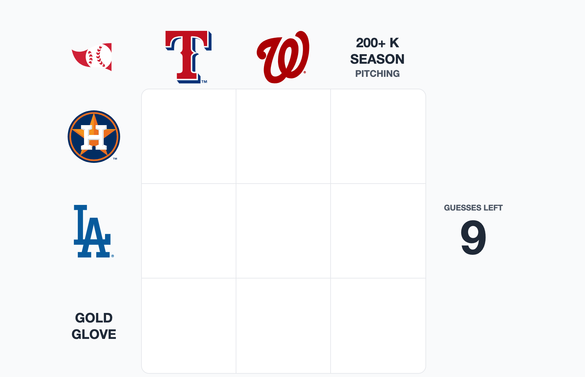
Generally speaking, there are always four teams, which means they are four squares dedicated to players who played for two different, specific teams. That means the best "cheat code" players are those who played for many different teams. Before we get there, though, I'll hit on a few other things.
As the great Ken Jennings will tell "Jeopardy!" hopefuls, you've got to know U.S. Presidents and the number that corresponds with them in addition to having great knowledge things like world capitals and Shakespeare. In the MLB immaculate grid world, our versions of these wheelhouses are:
- Pitchers with 300 wins (there are 24)
- Pitchers with 3,000 strikeouts (there are 19)
- Hitters with 3,000 hits (there are (there are 33)
- Hitters with 500 home runs (there are 28)
Not necessarily hardcore memorization, but if you generally know those lists, you'll be a much stronger Grid player.
Also, keep in mind that hits can be tricky. Some of the best players ever were so adept at drawing walks that they didn't reach 3,000 hits. Babe Ruth was a .342 career hitter, but he walked more than 2,000 times and ended up with 2,873 hits. But sometimes thinking too hard about the walk aspect can fool you. A few weeks ago, there was a 3,000-hit spot lined up with the A's and I stared at my screen trying to think of someone other than Rickey Henderson. I was sure Rickey walked too many times and didn't reach 3,000 hits. Even with his 2,190 walks, Rickey ended with 3,055 hits.
Rickey did not, however, have a 200-hit season. How about that one, huh? His season high in hits was actually 179.
A 200-hit season category often pops up and we're keep Rickey as our guiding light here to remember that a walk-heavy player very often did not reach 200 hits in a season. In fact, 200 hits in a season is really difficult. Players need to avoid injury, generally hit for a high average, not walk too many times and also hit toward the top of the order, otherwise they just won't get enough at-bats.
As an example here, the Phillies were lined up with a 200-hit season recently and I immediately thought that a lot of people might put Mike Schmidt in the box. He's one of the greatest Phillies ever (maybe the best) after all. But he never had more than 160 hits in a season. For real. He was a career .267 hitter who walked a ton and hit for a lot of power. An excellent OPS and WAR guy, for sure, but he won't help you in the 200-plus hits category. Think Jimmy Rollins types instead. He hit leadoff and had a low-ish walk rate for much of his career and hit for average in his best seasons. Sure enough, Rollins had 212 hits in 2007.
Hopefully this helps!
Above all, though, these are the most important rules:
- Do it however you want. Some people want to stare at their screen all night trying to think of someone who will check in at under 1% and pave the way for a ridiculous rarity score. Others just want to get a player in each box and call it a day. Some people just want to go from memory and others want to search a little on Baseball-Reference. Personally, in the case of the latter, I feel like it defeats the purpose and all trivia should just be from memory, but why the hell should anyone care what I think? It's your game. Enjoy it how you please.
- Have fun. There's no reason to make it feel like work. It's a game. If you don't find it fun and therefore don't want to play, don't.
Now, onto the players who played on lots of different teams. I know that the expansion teams -- specifically the four most recent: Marlins, Rays, Diamondbacks and Rockies -- present more of a challenge due to a lack of longevity, so I'll make note when a player below hits multiple from that group of four.
Immaculate Grid Cheat Code Players
The following players appeared in MLB with at least 10 different teams. Learn the list and dominate the grid.
Edwin Jackson - The all-time leader with 14 teams, a list that includes the Diamondbacks, Marlins and Rays, Edwin is possibly the most helpful player in this entire game. You only get to use him once per game, but there's no limit on how many games he appears.
Octavio Dotel - The career reliever appeared in the majors with 13 different teams, including the Rockies.
Rich Hill - The 43-year-old lefty is with the Pirates this season, his 12th team. One of his stops was with the Rays and we can't ignore those two outings with an infinite ERA on the Angels.
Mike Morgan - The right-hander finished his 22-year career with the Diamondbacks, where he won his first World Series ring. They were his 12th team.
Matt Stairs - He started his career with the Expos and finished it with the Nationals. All told, Stairs fits with 12 teams on the Grid. Don't forget about those 14 games with the Tigers.
Ron Villone - The southpaw is probably most known for his time with the Reds or Mariners, but he played for 12 different teams, including the Marlins, Rockies and Nationals.
Paul Bako - The journeyman backup catcher hung around for 12 years and played for 11 teams. The Marlins, Royals and Brewers are on the list along with older teams like the Cubs and Braves.
Miguel Batista - The D-Backs' third starter in 2001 after the vaunted duo of aces, Randy Johnson and Curt Schilling, Batista played for 11 teams in his career. That list includes the Marlins and also incredibly short stints with the Braves and Pirates.
Henry Blanco - Another stalwart backup catcher, Blanco played for 11 teams, including the Diamondbacks, Rockies, Brewers and Twins. He had a three-game stint with the Dodgers, too.
Bruce Chen - Another player who saw action with 11 teams, Chen squeezed into the lineup with the Expos, Royals, Red Sox, Rangers, and more.
Royce Clayton - The first shortstop on the list, Clayton played for 11 teams, including an eight-game stretch with the Red Sox.
Bartolo Colon - It's easy to remember Bartolo's runs with the A's and Mets in addition to Cleveland and the Angels. How about the Expos and White Sox, though? Red Sox? He played for 11 teams.
LaTroy Hawkins - Despite spending nine of his seasons with the Twins, he still ended up playing for 11 teams. One of them was the Rockies and that's always helpful.
Kenny Lofton - I'll fight anyone who thinks Lofton shouldn't be in the Hall of Fame. In the meantime, can you name the 10 non-Cleveland teams he played for? The other stops were all one season or less.
Terry Mulholland - Mulholland and Lofton were teammates on the 2003 Cubs! Mulholland spent time with 11 teams, also including the Diamondbacks and Mariners.
Dennys Reyes - The career lefty reliever spent time with 11 teams, including the Rockies and Diamondbacks.
Fernando Rodney - How many can you name? The Rays and Tigers, probably. The Diamondbacks and Marlins are also on the list, making Rodney very helpful.
Julián Tavárez - The lanky righty pitched for 11 teams, including the Rockies, Marlins, Brewers, Pirates and Nationals.
Rick White - In 12 years, the righty reliever hit 11 teams. The list includes the (Devil) Rays, Rockies and a really short stay in Seattle.
Todd Zeile - Yet another player to see time with 11 teams and it's a list that includes the Marlins, Rockies and Expos in addition to the Mets, Cardinals, Dodgers, Cubs and Yankees.
Russell Branyan - Always one of my faves from the school of low average, high strikeouts and huge power, Branyan bounced around to 10 teams, including the Diamondbacks, (Devil) Rays and incredibly short stays with the Cardinals and Angels.
Ken Brett - His brother, George, only played for one team, so if you need a Royals player for 3,000-plus hits, a 200-hit season, a .300-career batting average or a litany of other things, you can use him. Ken played for 10 teams, including the Royals, Pirates, Twins, and Brewers.
Marlon Byrd - Byrd played for 10 teams and you might have forgotten about nearly half of them, as he spent less than 40 games with the Giants, Pirates, Red Sox and Cleveland (which counts for the Guardians, obviously).
Tyler Clippard - Of his 10 teams, it's probably easiest to remember the Nationals and Yankees, but there are also the Diamondbacks, A's, Mets and some others.
Tommy Davis - A three-time All-Star who spent eight seasons with the Dodgers, he bounced around after that and ended with 10 teams. He even saw time with the Seattle Pilots and that should count for the Brewers.
Ross Detwiler - Through his age-28 season, Detwiler had only been with the Nationals. He saw time with nine teams after that, including the Marlins, Mariners, Padres and A's.
Alan Embree - The long-time lefty reliever played for 10 teams, including the Rockies, Diamondbacks, A's and Yankees.
Dana Eveland - Ten teams in 11 years is quite the feat and Eveland pulled it off. The D-Backs and Rays are in there.
José Guillén - Who do you most remember him with? The Pirates, Royals, Devil Rays or Reds? Maybe Nationals? He played for 10 teams in 14 years.
Roberto Hernández - This would be the long-time reliever, not the artist formerly known as Fausto Carmona. This Hernández spent seven years with the White Sox but also played for nine other teams, including the (Devil) Rays and Royals.
Kevin Jarvis - Ten teams in 12 years for this pitcher. The Reds, Rockies, Diamondbacks, A's, Tigers and Twins are on the list.
Cameron Maybin - I've already used him multiple times. Thanks, Cameron! In his 15 years at the major-league level, Maybin played for 10 teams, including the Marlins, Mariners, Astros, Cubs and Mets.
Dan Miceli - Ten teams in 14 years for the reliever, a career that had stops with the Pirates, Rockies, Padres, Marlins, (Devil) Rays, Yankees, Rangers and Tigers.
Bob Miller - This happened back before it was more common. Miller debuted in 1957 with the Cardinals and his last year came with the Mets in 1974. In all, Miller played for 10 teams, including a very short stop with the Cubs.
René Rivera - Another backup catcher, Rivera played for 10 teams in 13 years with brief stops in Atlanta and D.C. He also played for the Rays, Angels and Twins.
Russ Springer - The career reliever logged 740 appearances for 10 teams in 18 years. Among the teams he played for: Yankees, Reds, Diamondbacks, Rays and A's.
Anthony Swarzak - The reliever ended his career after spending time with the Diamondbacks and Royals in 2021, getting him up to 10 teams.
Brett Tomko - Tomko's 10 teams include the A's, Rangers, Yankees, Padres and Reds.
Jamey Wright - Unfortunately for Wright, he made his MLB debut as a pitcher with the Rockies in the '90s. He also spent time in some more pitcher-friendly environments, such as with the Royals, Mariners, Rays and Giants.









